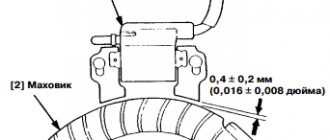What is a dimmer and why is it needed?
A dimmer is an electronic device capable of regulating power by regulating the voltage supplied to the load. The definition is very dry and boring, let's explain the principle of operation in simpler language.
Power depends on the voltage and current in the load. This means that if you reduce one of the components, the power will also decrease. Voltage and current are related by Ohm's law, which means you can reduce the power of your device (brightness of the lamp) by increasing the total load resistance. That is, use ballast resistors, chokes or capacitors.
Ballast power absorbers - convert excess energy into heat and have low efficiency. To regulate the power of the device, in our case the brightness of the light bulb, you need another device - a dimmer.
Is it possible to connect LED lamps via a dimmer? Can. But not everything will be consistently regulated. Here you need special LED lamps for dimmer.
LED lamps, adjustable with a dimmer , are suitable for use with any regulator. But there are some nuances in the difference between the type of voltage regulation. This is determined by the dimmer's circuitry; the differences will be described in detail in the following sections of the article. The type of dimmer determines how well the LEDs will be regulated.
Which LED lamps can be used with a dimmer? In this matter, everything is extremely individual. It all depends both on the circuit of the light bulb itself and on the circuitry of the regulator. In general, so-called dimmable LED lamps are excellent.
Dimmer device
It is easiest to consider a standard diagram of a regulator device using the example of a rotary variator, the design of which is characterized by simplicity of execution, but may differ in build quality and number of components.
The power of the triac should be 20–50% higher than the load
The triac regulator circuit is usually the same, but the main difference is the presence of some additional elements that provide more stable operation under conditions of low output voltage.
The triac must remain operational at a voltage of 400 V
The actual dimmer circuit is indicated taking into account the differences in some parameters in devices produced by different manufacturers. In this case, triacs can be anything, but they directly depend on the load power indicators. The values of resistors and capacitors are influenced by the starting and ending ignition points.
What types of dimmers are there?
Power regulators can be divided into two large groups:
- For work in alternating voltage circuits (220V);
- for operation in constant voltage circuits (for 12V LED strip).
Drills also need a regulator to adjust the speed; it is located in the button.
It can be used for a variety of purposes, listed in order of popularity:
- Light brightness adjustment, dimming of LED and incandescent lamps;
- adjusting the heating element temperature in various heaters;
- adjusting the speed of the commutator motor.
Popular manufacturers
When choosing a light controller, you need to pay attention to additions, markings or markings:
- the Latin letter R means that this type of device is designed for incandescent lamps with an ohmic or resistive load;
- the Latin letter L indicates that this type of device is allowed to work with transformers under inductive load conditions;
- the Latin letter C indicates that this type of device is allowed to work with electronic transformers with a capacitive load.
In accordance with numerous reviews, a rating of the best brands of CVTs from the most worthy and well-established manufacturers has been determined.
What are the differences between dimmers?
If you are going to use a switch with brightness control, you first need to find out what they are. And in general, can all LED lamps be dimmed?
Dimmers differ according to the following criteria:
- By type of installation;
- on execution and method of management;
- according to the method of regulation.
Let's take a closer look at each of them.
By installation type
For outdoor installation – surface-mounted switch with dimmer for LED lamps. To install such a device, you do not need to drill a niche in the wall; it is simply mounted on top of the wall. It is very convenient to use in cases where the interior is not a priority or external wiring is installed.
For indoor installation - they will fit perfectly into any interior, such as this one.
For DIN rail mounting they are very specific and at first it may seem that they are not practical. However, this dimmer for LED lamps works with a remote control, and is hidden from prying eyes in the electrical panel.
By execution
According to the design, the light controller for LED and incandescent lamps can be:
- Rotary;
- rotary-push type;
- push-button;
- sensory;
Rotary is one of the simplest options for dimming an LED lamp; it looks unpretentious and has the simplest functionality.
The turn-and-push one looks almost the same as the rotary one. Thanks to its design, when you press it, the light turns on with the same brightness as it was set the last time you turned it on.
A push-button controller for LED lighting looks more technologically advanced and will fit seamlessly into a modern apartment. Like this switch with a dimmer for LED lamps.
Touch models can be completely different - from luminous circles to smooth single-color panels for adjusting the voltage of LED lamps.
According to the adjustment method
Dimmers vary not only in their design, but also in their operating principle. This applies specifically to AC dimmers.
type of dimmer is more common and cheaper, due to the simplicity of its circuit - a leading edge cutoff dimmer . A little further on, its operating principle and circuit will be discussed in detail; for comparison, take a look at the type of voltage at the output of such a regulator.
The graph shows that the remainder of the half-wave is supplied to the load, and its beginning is cut off. Due to the nature of the load switching on, interference is generated in the electrical networks, which interferes with the operation of televisions and other devices. A voltage of the set amplitude is applied to the lamp, and then it fades out when the sine wave passes through zero.
Can a leading edge dimmer be used for LED lamps? Can. LED lamps with a dimmer of this type will only be well adjustable if they were originally designed for this. This is evidenced by the symbols on its packaging. They are also called “dimmable”.
The second type works differently, creates less interference and works better with different light bulbs - this is a falling edge dimmer .
LED lamps with this type of dimmer adjust better, and its design better supports non-dimmable light sources. The only drawback is that these lamps can adjust their brightness not from “zero”, but within a certain range. At the same time, dimmable LED lamps are simply superbly adjustable.
The best solution is to use a Falling Edge LED dimmer.
A special word can be said about ready-made LED lamps with adjustable brightness. This is a separate class of lighting devices that do not require the installation of additional regulators, but have them in their design. Their adjustments are made using buttons on the case or from the remote control.
Dimmer circuits
Dimmer for 220V voltage, with leading edge cut-off, works on the principle of phase-pulse voltage control. During operation, the elements of such a dimmer supply voltage to the load at certain moments, cutting off part of the sinusoid. This is depicted in detail and more clearly in the graphs.
The area of the sinusoid shaded in gray is the area of the voltage or its effective value that is supplied to the load (a lamp or any other device described above).
The red dotted line shows the voltage waveform at the dimmer input for LED lamps. In this form, it is supplied through a regular switch without adjustments .
How to connect LEDs via a dimmer?
Component ratings and all information are indicated on the dimmer diagram.
The device is installed in a break in the wire going to the light source, motor, heating element or any other device.
The logic of the circuit is as follows: capacitor C1 is charged through chain R1 and potentiometer R2. Depending on the position of the potentiometer, the capacitor is charged to the opening voltage of the dinistor VD1.
The circuit used a DB3 dinistor, which is approximately 30V. Through an open dinistor, a control pulse for opening a triac (bidirectional thyristor) is supplied to its control electrode.
The greater the resistance set by the potentiometer knob, the longer it takes for the capacitor to charge, respectively, the later the dinistor-triac circuit will open, and the voltage will be lower, since most of the sine wave will be cut off. And vice versa - less resistance means more voltage at the output of the regulator.
There are many options for circuits on the Internet with all sorts of modifications, all of them are good. Here is a simple diagram; the figure shows the installation of this version of the scheme.
Application
Due to their simplicity of design and functionality, modern dimmers are widely used.
Main directions:
- Creation of different lighting modes in one and/or several rooms.
- Reducing electricity costs by switching lighting to standby mode.
- In a power tool to reduce and increase the speed of a commutator electric motor.
- Zoning a room into several conventional areas.
- Illumination of art objects, for example, sculptures or paintings. Different degrees of lighting allow you to draw more attention to the exhibit.
- Creating the illusion of a person being in an apartment/house by changing the lighting level.
- In electric heaters to regulate their power.
- Change brightness for birds/animals that have special requirements for this parameter.
- Warming chicks immediately after birth. Depending on the degree of brightness, the degree of heating also changes.
- Carrying out home parties when brighter lighting is required at the table, and dim lighting in the dance area.
- Creating an intimate atmosphere in the bedroom.
The scope of application of dimmers is huge, and everyone can come up with a new option, taking into account the capabilities of the electronic device.
The dimmer is equipped with a microcontroller and has a wide range of options:
- changing the brightness level;
- automatic shutdown;
- creating the effect of the presence of people thanks to automatic on/off;
- flashing/dimming modes;
- smooth switching on/off of lighting;
- remote control via IR channel, radio channel, acoustic noise (for example, cotton), etc.
How to adjust LED lighting
What light bulbs can be used with a dimmer? When mainly incandescent lamps were used for lighting, everything was simple - a regular dimmer could easily cope with adjusting the brightness.
Incandescent light bulbs were replaced by energy-saving fluorescent light bulbs and could not be dimmed at all. Of course, there were electronic ballasts for tubular fluorescent light bulbs with dimmable capabilities, but they were extremely rare and they were expensive.
Now energy-saving lamps are being replaced by LED lamps. The process of emitting light quanta, although complex, is, from a regulatory point of view, perhaps simpler than regulating gas-discharge light sources.
Dimmable LED lamps - what are they?
What does dimmable LED lamp mean? This is a light bulb that can be dimmed using ANY dimmer that is designed for alternating or direct current (depending on the type).
Its power circuit includes functions for changing brightness, depending on the supply voltage. Dimmable LED lamps work with dimmer circuits like the one shown above.
The network dimmer regulates the supplied voltage. This means that at any voltage values, within the range specified by the manufacturer (it is indicated on the light bulb box), the lamp circuit will strive to maintain the specified current. Brightness in turn depends on current.
Regular LED lamps cannot be adjusted; at best, they will simply turn on and off; at worst, they will burn out at low values set on the dimmer.
The cheapest LED lamps have a quenching capacitor. Even if they are regulated, it will be only within very narrow limits, which means they are also not suitable. For an example of dimming conventional LED light bulbs, watch the video.
Dimmable LED lamps 220 Volt
Adjusting the brightness of 220V LED lamps is difficult because there is a current stabilization circuit installed on a specialized driver. Its task is to stabilize the output current to ensure a uniform and long-lasting glow of the LEDs, regardless of the supply voltage.
Conventional LED lamps are not very dimmable. To choose the right LED lamp for a dimmer, you need to carefully study the description and symbols indicated on the box and body of the light bulb.
LED lamps with dimming can be recognized by the inscription: “for dimmer”, “adjustable” or something similar; perhaps a conventional image of a dimmer will simply be drawn, as in the examples below.
Is it possible to adjust the brightness of LED lamps running on DC?
The photo shows a led dimmer for a 12V LED strip. Let's figure out how such a dimmer works with LED lamps.
For DC circuits, the operating principle of the regulator is different. Here, a bipolar or field-effect transistor is used as a metering element, and a pulse generator with a variable duty cycle is used as a metering element.
The method of this control is called pulse width modulation (PWM). To understand how this works you need to look at the graphs.
Vcc is the voltage at the DC dimmer input, Vaverage is the output voltage. You can see how the average voltage changes. As the pulse duration increases and the pause length decreases (we increase the duty cycle), the output voltage increases.
Above is a circuit diagram of a “PWM dimming controller for LED lamps on NE555.” It can act as a device for dimming LEDs. It works like this:
NE555 is a timer, connected here in the pulse generator mode, the frequency and duration of which is set by an RC circuit consisting of R2, potentiometer R1 and capacitor C5, as in the previous circuit, the potentiometer regulates the charging rate of the capacitor, and the pulse width is formed in accordance with the charging speed.
Initially, the circuit produces symmetrical pulses, that is, the pause length is equal to the pulse length. But thanks to the presence of a potentiometer and a chain of two diodes VD1 and VD2, the capacitance is charged and recharged through different resistances of the potentiometer, or rather through different pairs of its contacts.
Therefore, PWM adjustable pulses are generated with a constant frequency, but a variable duty cycle.
If you use it in a car or for dimming an LED strip, you can eliminate the additional 9 volt power supply based on the 7809 linear regulator and supply power to the first point after it in the circuit.
But here are photos of a homemade dimmer for LEDs, if necessary, you can copy the location of the tracks and repeat it. Or assemble it on a breadboard.
A video of how dimming LED lamps works using this circuit, using a side-glow strip as an example, is located below.
Using this circuit, it is possible to dim 12V LED circuits and any other DC load. For example, adjust the speed of revolutions of a PC cooler, brushed motors, heaters, in general, anything you can think of. In one of the articles we already talked about making an LED dimmer with your own hands.
What dimmer is needed for LED light bulbs?
To select a dimmer for LED lamps and ensure their compatibility, you must first decide which lamps you will use. If you are planning to buy 220V LED light bulbs, phase-pulse devices, which were discussed at the beginning of the article, are suitable for this. Take models with trailing edge cut-off.
For low-voltage DC lamps (for example, 12V, which are used in spotlights, table lighting or car lamps), any PWM controller or dimmer for LED strips will do. They all work on the principle of pulse-width modulation; linear regulation is already a thing of the past.
It is also better to buy special LED lamps for dimmer. Although they are more expensive, there will be no problems with their adjustment. You will create the desired lighting solution only if you choose the right dimmer and LED lamps for it.
Share your experience in adjusting the brightness of LEDs and LED lamps in the comments!
Please rate the article. We tried our best:)
Did you like the article? Tell us about her! You will help us a lot :)











